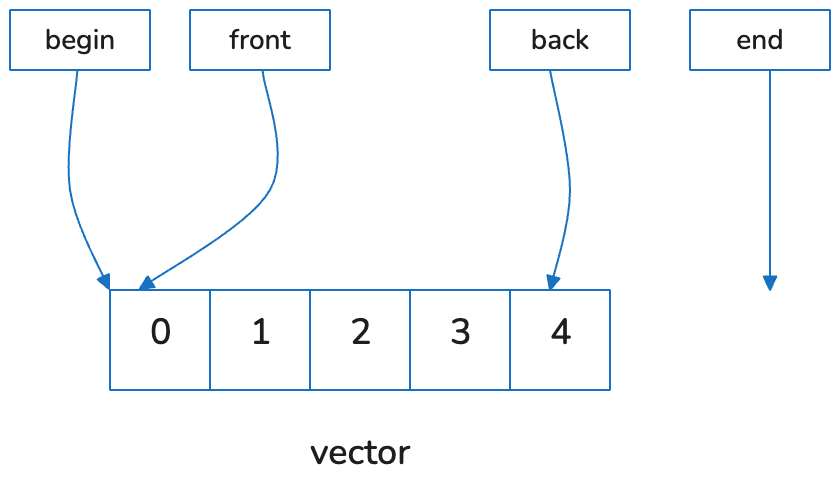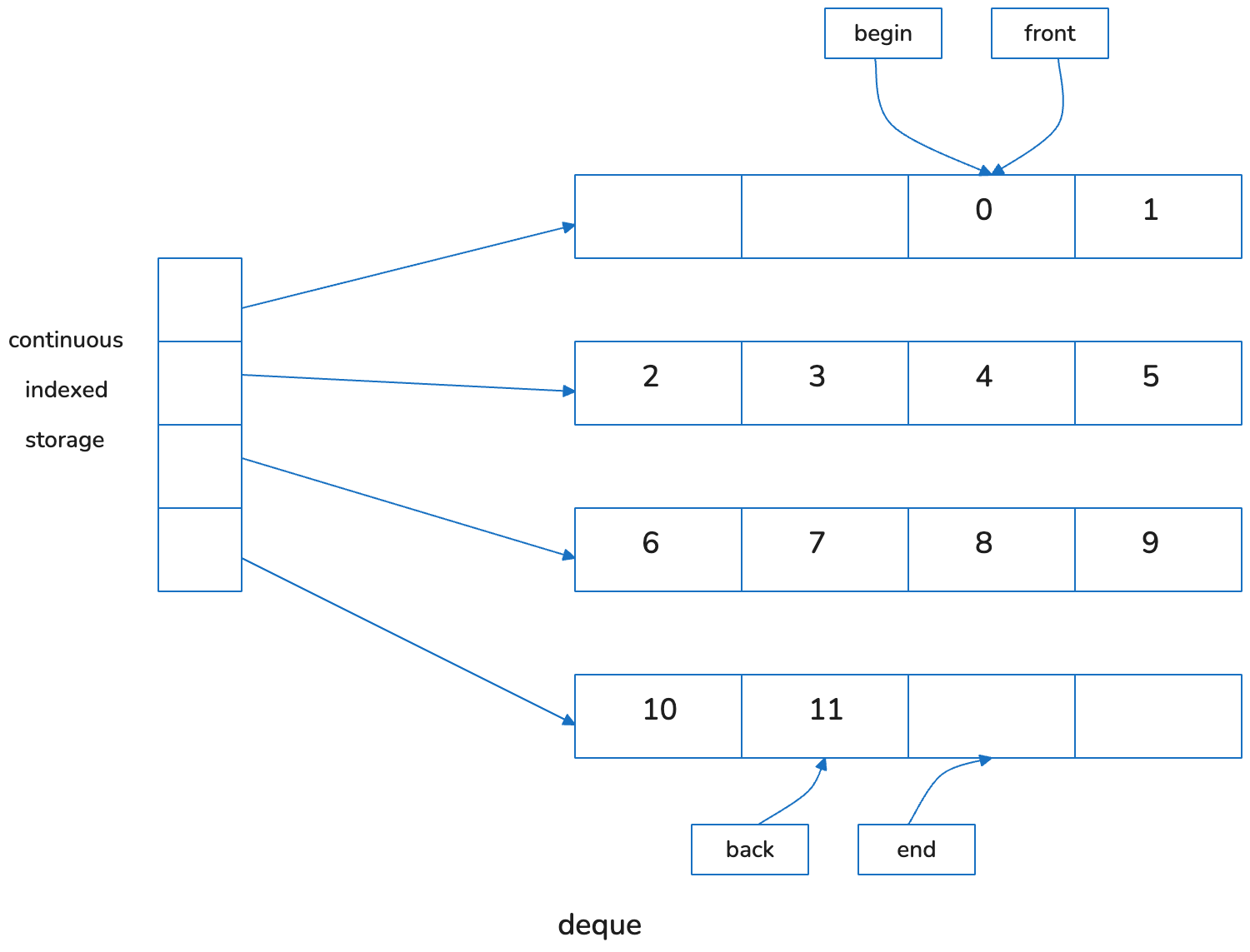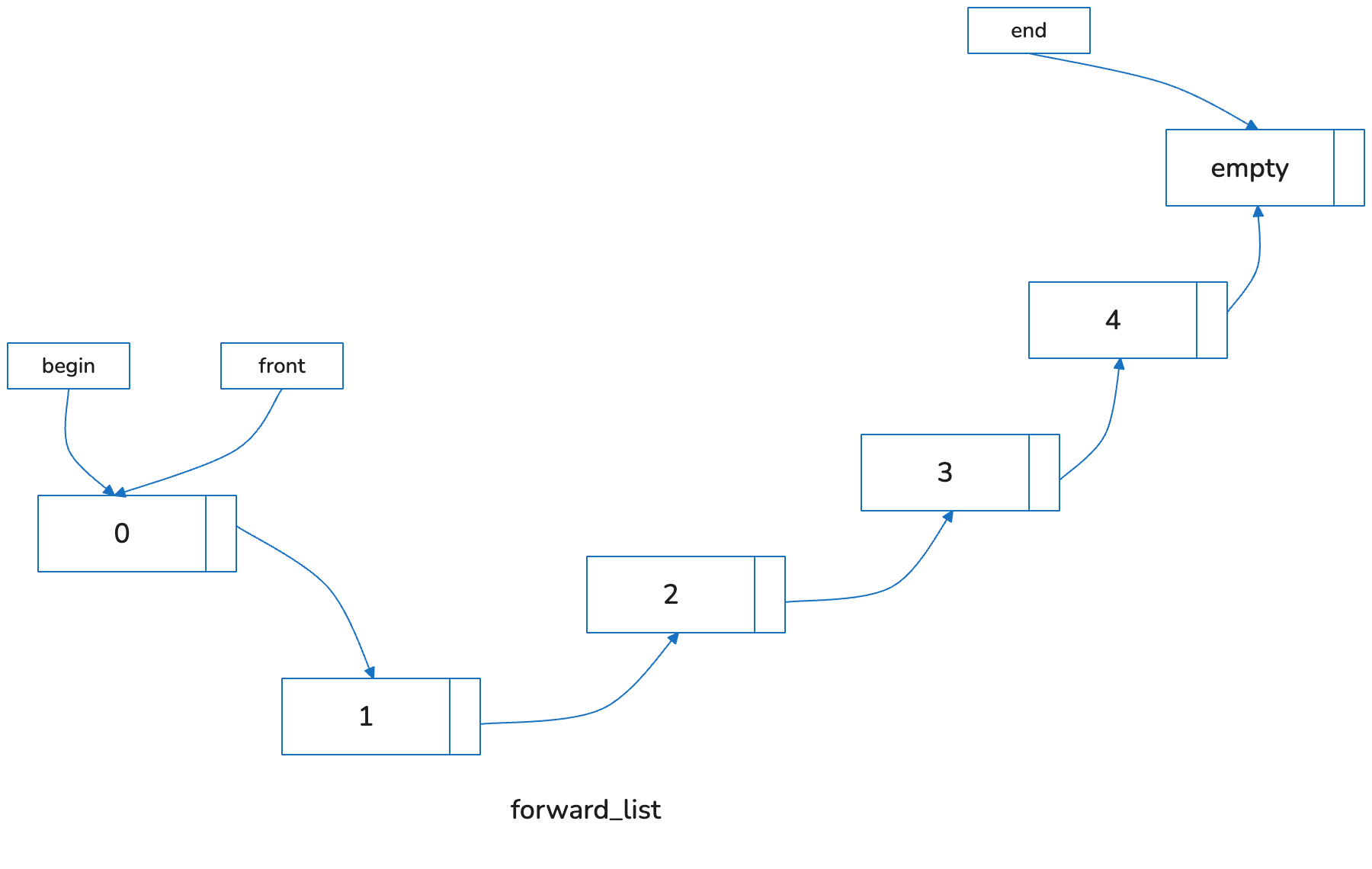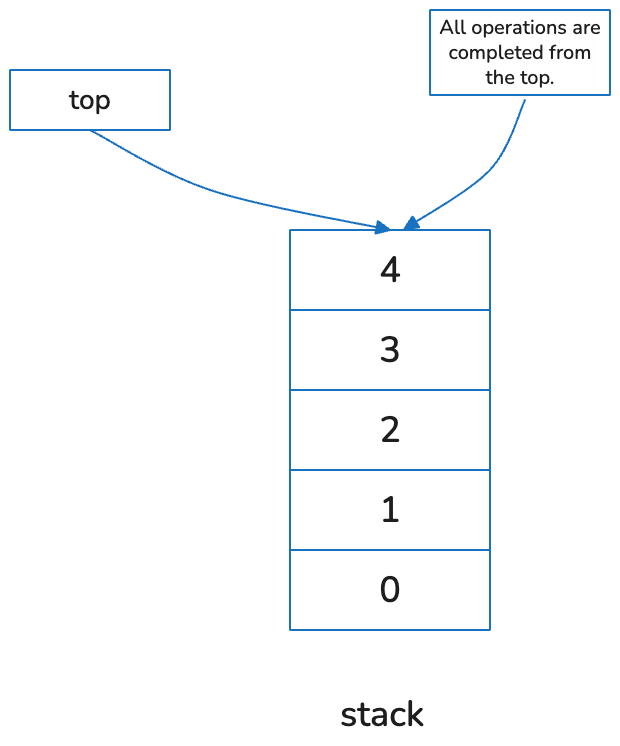There are already plenty of learning materials about containers. For reference, cppreference offers very comprehensive documentation. Today, we’ll take a more informal approach. Rather than repeating existing reference material, we’ll try to deepen your understanding of some key containers.
string
Strictly speaking, string is not usually classified as a container in C++. But since it shares many similarities with containers, we’ll start with string.
string is a specialization of the template basic_string for the char type. You can think of it as a container that stores char elements. The main difference between string and “true” container classes is that containers can store objects of any type.
Like most containers, string provides the following member functions:
begin()— returns an iterator to the startend()— returns an iterator to the endempty()— checks whether it’s emptysize()— returns the sizeswap()— swaps contents with another container
(For those unfamiliar with C++ containers: C++ uses half-open intervals for begin and end: when non-empty, begin points to the first element and end points to one past the last element; if empty, begin == end. In the case of string, for compatibility with C strings, end refers to the position after the terminating \0 character.)
These features are shared by almost all containers:
- Containers have a beginning and an end
- Containers can check if they’re empty
- Containers track their size
- Containers support swapping
Of course, these are just common features; each container serves a different purpose.
Memory Layout of string:

The memory layout of string is very similar to vector, as you’ll see later. In both structure and functionality, string and vector are closely related.
The main purpose of string is to store strings. Unlike C-style strings:
stringautomatically manages memory and lifecycle.stringsupports concatenation (+and+=operators).stringsupports searching (find,rfind).stringallows safe reading fromistream(usinggetline).stringallows passing data to functions expectingconst char*(viac_str()).stringsupports conversion to and from numbers (stoiseries,to_string()).
Whenever possible, you should use string for string management in your code. However, when designing interfaces, things get a bit more complicated. Generally, I don’t recommend using const string& in function parameters unless you’re sure the caller already has a string. If the function does little processing, using const char* avoids unnecessary construction and destruction of string objects when the caller only has a C string, which can be costly.
If your function implementation needs to use string functions, consider:
- Use
const string&orstring_view(C++17) for read-only access.string_viewis ideal because even C strings won’t cause extra memory copies. - Use
string(by value) if you need to modify the string internally without affecting the caller. - Use
string&if you intend to modify the caller’s string (usually not recommended).
You’re likely already familiar with string. Here’s a simple example:
string name;
cout << "What's your name? ";
getline(cin, name);
cout << "Nice to meet you, " << name << "!\n";
vector
vector is probably the most widely used container. Though its name comes from mathematics, it’s more accurate to think of it as a dynamic array. It’s roughly equivalent to Java’s ArrayList or Python’s list.
Just like string, elements in a vector are stored in contiguous memory, and functions like begin(), end(), front(), and back() behave similarly. The memory layout is very similar to string:

Besides the general container features, vector supports the following operations (partial list):
- Element access via subscript
[](likestring) data()returns a raw pointer to the data (likestring)capacity()returns the size of allocated memory (in elements) (likestring)reserve()adjusts allocated capacity; after success,capacity()changes (likestring)resize()changes the actual size; after success,size()changes (likestring)pop_back()removes the last element (likestring)push_back()adds an element at the end (likestring)insert()inserts an element before a specified position (likestring)erase()removes an element at a specified position (likestring)emplace()constructs an element directly at a specified positionemplace_back()constructs an element directly at the end
Pay attention to functions like push_... and pop_.... When these exist, it usually means that insertions and deletions at those positions are efficient. For vector, inserting or deleting at the end is efficient due to its contiguous memory layout; other positions require shifting elements unless memory reallocation occurs.
When functions like push_back, insert, reserve, or resize cause memory reallocation, or when insert or erase move elements, vector tries to move elements to the new memory region. vector typically guarantees strong exception safety. If your element type does not provide a noexcept move constructor, vector will fall back to copying instead.
Therefore, for custom types that are expensive to copy, you should define a move constructor and mark it noexcept, or store smart pointers in the container. That’s why we earlier marked move constructors as noexcept in our smart_ptr example.
Here’s a demonstration:
#include <iostream>
#include <vector>
using namespace std;
class Obj1 {
public:
Obj1() { cout << "Obj1()\n"; }
Obj1(const Obj1&) { cout << "Obj1(const Obj1&)\n"; }
Obj1(Obj1&&) { cout << "Obj1(Obj1&&)\n"; }
};
class Obj2 {
public:
Obj2() { cout << "Obj2()\n"; }
Obj2(const Obj2&) { cout << "Obj2(const Obj2&)\n"; }
Obj2(Obj2&&) noexcept { cout << "Obj2(Obj2&&)\n"; }
};
int main() {
vector<Obj1> v1;
v1.reserve(2);
v1.emplace_back();
v1.emplace_back();
v1.emplace_back();
vector<Obj2> v2;
v2.reserve(2);
v2.emplace_back();
v2.emplace_back();
v2.emplace_back();
}
Sample output:
Obj1()
Obj1()
Obj1()
Obj1(const Obj1&)
Obj1(const Obj1&)
Obj2()
Obj2()
Obj2()
Obj2(Obj2&&)
Obj2(Obj2&&)
Notice that the only difference between Obj1 and Obj2 is the noexcept on the move constructor — yet this small difference changes whether vector chooses to move or copy objects. This is very important.
The emplace... family of functions was introduced in C++11 to improve container performance. Try changing v1.emplace_back() to v1.push_back(Obj1()). The result will be the same, but push_back creates an extra temporary object, resulting in an extra (move or copy) constructor call and destructor call. If moving is cheap, the difference is small; if only copying is allowed, the performance difference can be significant.
Modern CPU architectures heavily favor contiguous memory access. vector’s contiguous layout is a major performance advantage. When you’re unsure which container to use, default to vector.
The main downside of vector is that resizing may require relocating many elements. If you know in advance that the container will grow large, call reserve() early — this can bring significant performance gains.
Here’s the full English translation of your text:
deque
deque stands for double-ended queue. Its main purpose is to support:
Adding and removing elements freely from both the front and the back of the container.
Compared to vector, deque has the following differences:
dequeprovidespush_front,emplace_front, andpop_frontmember functions.dequedoes not providedata,capacity, orreservefunctions.
Memory Layout:

- If you only insert or remove elements at the front or back, objects inside the
dequenever need to be moved. - Elements are partially contiguous (which is why there’s no
data()function). - Since most of the storage is still contiguous, iteration performance remains quite good.
- Storage is split into equal-sized chunks. Subscript access is efficient, roughly implemented as:
index[i / chunk_size][i % chunk_size].
If you need a container that frequently inserts and removes elements from both ends, deque is a good choice.
list
In C++, list represents a doubly linked list. Compared to vector, it’s optimized for inserting and deleting elements in the middle:
listprovides efficient O(1) insertions and deletions at any position.listdoes not support random access via subscript.- Like
deque,listprovidespush_front,emplace_front, andpop_front. - Like
deque, it does not havedata,capacity, orreserve.
Memory Layout:

Although list offers flexibility to insert elements at any position, since each element is allocated separately in non-contiguous memory, its iteration performance is worse than both vector and deque. This significantly offsets the theoretical advantage of not having to move elements during insertion or deletion.
If you don’t need to iterate much but often insert or remove elements in the middle, list can be a good choice.
Another thing to note: since certain standard algorithms don’t work with list, it offers its own member functions as replacements, including:
mergeremoveremove_ifreversesortunique
Example:
#include "output_container.h"
#include <iostream>
#include <algorithm>
#include <list>
#include <vector>
using namespace std;
int main()
{
list<int> lst{1, 7, 2, 8, 3};
vector<int> vec{1, 7, 2, 8, 3};
sort(vec.begin(), vec.end()); // works fine
// sort(lst.begin(), lst.end()); // error
lst.sort(); // works fine
cout << lst << endl;
// Output: { 1, 2, 3, 7, 8 }
cout << vec << endl;
// Output: { 1, 2, 3, 7, 8 }
}
forward_list
Since list is a doubly linked list, is there a singly linked list in C++? The answer is yes: starting from C++11, forward_list became part of the standard library.
Memory Layout:

Most C++ containers support an insert function to insert an element before a specified position. For forward_list, this is hard to achieve (think about why), so the standard library instead provides insert_after.
Compared to list, forward_list lacks:
backsizepush_backemplace_backpop_back
Why would we want this more limited version of list? Because for small elements, forward_list can save a significant amount of memory; and for short lists, not being able to traverse backwards usually isn’t a big problem. Better memory utilization often leads to better performance, especially when memory is tight.
For now, it’s enough for you to simply know that forward_list exists. If you don’t feel a need for it, you probably don’t need it.
queue
Before wrapping up, let’s briefly introduce two more container-like types. These are not full containers but rather container adaptors — they wrap existing containers.
First up is queue, a first-in, first-out (FIFO) data structure.
By default, queue is implemented on top of deque. Compared to deque, it has the following changes:
- No random access via subscript.
- No
begin()orend(). emplacereplacesemplace_back;pushreplacespush_back;popreplacespop_front.- No other
push_...,pop_...,emplace...,insert, orerasefunctions.
Its actual memory layout depends on the underlying container. Conceptually, its structure looks like this:

Since queue doesn’t offer iterators, we cannot directly iterate through it. Instead, we typically write:
#include <iostream>
#include <queue>
int main()
{
std::queue<int> q;
q.push(1);
q.push(2);
q.push(3);
while (!q.empty()) {
std::cout << q.front() << std::endl;
q.pop();
}
}
stack
Similarly, stack is a last-in, first-out (LIFO) data structure.
By default, stack is also implemented using deque, but conceptually it’s more similar to vector. Compared to vector, its differences are:
- No random access via subscript.
- No
begin()orend(). backbecomestop; nofront.emplacereplacesemplace_back;pushreplacespush_back;popreplacespop_back.- No other
push_...,pop_...,emplace...,insert, orerasefunctions.
Usually, stack is visualized like a vertical vector:

A small detail to be aware of: the direction of growth for stack differs from the system memory stack we discussed earlier. In stack, the bottom is the low address and grows upward; in memory management, it’s typically the reverse (high address at the bottom, grows downward). This distinction usually doesn’t matter when using stack, but it helps avoid confusion if you ever need to inspect memory structures.
Example code (similar to queue, but reversed output):
#include <iostream>
#include <stack>
int main()
{
std::stack<int> s;
s.push(1);
s.push(2);
s.push(3);
while (!s.empty()) {
std::cout << s.top() << std::endl;
s.pop();
}
}
